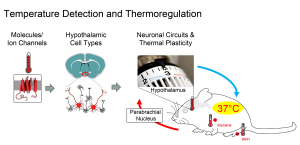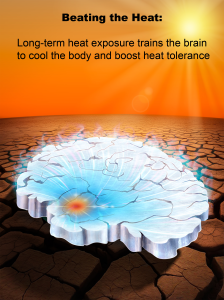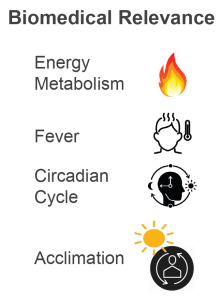

The ability of any living organism to sense stimuli emanating from the surrounding environment is complemented by the ability to probe and detect inner parameters defining the internal state of the body (such as blood sugar levels, osmolarity, pH and others). Together, processing and integration of sensory information from the outside world and the internal environment ––interoception–– allows the organism to maintain homeostasis and adapt to outside stressors.

In our lab, we are particularly interested in temperature, a parameter that is modulating and affecting every aspect of live, at the organismic, tissue and cellular level, and down to every enzymatic reaction. Most, if not all, organisms can in some way sense temperature and react to it, which is critical for their survival –– temperature detection likely represents one of the primordial senses developed very early on in the course of evolution. For the identification of key molecules detecting temperature by the nervous system, the TRP ion channels, David Julius and Ardem Patapoutian were awarded the Nobel Prize in 2021.
Internal temperature is tightly regulated in mammals, down to a few tenths of a degree Celsius, by controlling peripheral organs that mediate heat-gain and heat-loss. We are only beginning to understand the cellular mechanisms and circuits that govern and orchestrate thermal homeostasis. In all vertebrates the hypothalamus, and in particular the hypothalamic preoptic area (POA), is considered the main CNS hub: processing thermal information, integrating it with other internal state parameters, and regulating body temperature –– from a reductive viewpoint, the POA is our biological “thermostat”.
Research Interests
We are interested in understanding how the preoptic “thermostat” operates, on the molecular, cellular and circuit level, and how it interacts with peripheral organs to accomplish thermal homeostasis. We have recently also become interested in studying thermal plasticity and the adaptation of the “thermostat” to long-lasting increases in environmental temperatures.  Our data suggest that the POA has a primary role in establishing resilience to hot temperatures upon prolonged exposure to environmental heat, a phenomenon commonly known as acclimation or acclimatization. More generally, we are interested in assessing the therapeutic potential of the preoptic “thermostat”: the POA is connected to brain regions controlling energy expenditure and increasing body temperature ––thermogenesis–– requires burning of fuel. Thus, manipulating the preoptic “thermostat” could potentially be utilized to treat obesity.
Our data suggest that the POA has a primary role in establishing resilience to hot temperatures upon prolonged exposure to environmental heat, a phenomenon commonly known as acclimation or acclimatization. More generally, we are interested in assessing the therapeutic potential of the preoptic “thermostat”: the POA is connected to brain regions controlling energy expenditure and increasing body temperature ––thermogenesis–– requires burning of fuel. Thus, manipulating the preoptic “thermostat” could potentially be utilized to treat obesity.
In future research we are interested in an “evo-devo” type of approach ––potentially using primordial model organism(s)–– to study how internal temperature sensing and thermoregulation have evolved. We believe this research to expand our insight into generalizable physiological mechanisms governing thermoregulation and it may point to interactions with other homeostatic systems and unrecognized therapeutic potential.
Next to these main lines of interests we have focused interest also on related areas that, historically, were the starting point of our teams shift to temperature research:
Scientists and aspiring scientists at the post graduate or undergraduate level interested in any of these research areas are more than welcome to contact Jan Siemens at jes[at]pharma.uni-heidelberg.de to explore the possibility of joining our team for an internship, a Master thesis, Doctoral thesis or Postdoctoral studies.